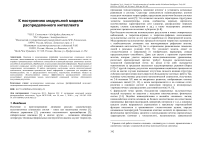К построению модульной модели распределенного интеллекта
Автор: Словохотов Ю.Л., Неретин И.С.
Журнал: Труды Института системного программирования РАН @trudy-isp-ran
Статья в выпуске: 3 т.30, 2018 года.
Бесплатный доступ
Описание и моделирование динамики мультиагентных социальных систем методами, заимствованными из статистической физики «неживых» многочастичных систем, не отражает принципиальную особенность совокупности взаимодействующих автономных агентов: способность воспринимать, обрабатывать и использовать внешнюю информацию. Распределенный интеллект социальных систем следует непосредственно учитывать в их экспериментальных и теоретических исследованиях. В работе предложена «модульная» модель интеллектуальной деятельности, включающая производство новой информации и пригодная для описания как индивидуального, так и распределенного интеллекта, перечислены возможные области ее использования. «Количественную оценку» эффективности распределенного интеллекта иллюстрирует компьютерная модель искусственной социальной системы; обсуждаются полученные результаты.
Мультиагентные социальные системы, распределенный интеллект, моделирование интеллектуальной деятельности
Короткий адрес: https://sciup.org/14916549
IDR: 14916549 | DOI: 10.15514/ISPRAS-2018-30(3)-23
Список литературы К построению модульной модели распределенного интеллекта
- Moussaïd M, Helbing D, Theraulaz G, How simple rules determine pedestrian behavior and crowd disasters PNAS, 108 (17), 2011, pp. 6884-6888
- Goubko M.V.,Novikov D.A. Game theory in control of organizing systemsТ. 2-nd ed. Moscow, Sinteg, 2005, 138 p.
- Galam S. Sociophysics: a physicist's modeling of phycho-polytical phenomena. Springer, 2012, 439 p.
- Zakharov A.V. Models of political competition^ a review. Economics and Mathematical Methods , 45 (1),, 2009 pp. 110-128
- Dorogovtsev S.N. Lectures on Complex Networks. Clarendon: Oxford, 2010, 134 p.
- Newman M.E.J., The structure and functions of complex networks, SIAM Review, 45(2), 2003, pp. 167-225.
- Bernovskiy M.M., Kuzyurin N.N. Random graphs, models and generators of scale-free graphs. Trudy ISP RAN/Proc. ISP RAS, 2012, v. 22, pp. 419-432 DOI: 10.15514/ISPRAS-2012-22-22
- Yevin I.A. Introduction to a theory of complex networks. Computer Research and Modeling , 2 (2), 2010, pp. 121-141.
- Novikov D.A. Models of strategic behavior. Automation and Remote Control, 73 (1), 2012, pp. 1 -19
- Kahneman D. Maps of Bounded Rationality: Psychology for Behavioral Economics Amer. Econ. Rev., 2003, 93(5), pp. 1449-1475.
- Gasnikov A.V. (Ed.). Introduction into mathematic modeling of traffic flows. Moscow, MTsIMO, 2013, 428 p.
- Adamchuk A.N., Esipov C.E. Collectively fluctuating assets in the presence of arbitrage opportunities, and option pricing. Phys. Usp., vol. 40, 1997, pp. 1239-1248
- Schelling T. Dynamic models of segregation. J. Math. Sociol., 1 (2), 1971, pp. 143-186
- Castellano C., Fortunato S., Loreto V. Statistical physics of social dynamics. Rev. Mod. Phys. 81 (2), 2009, pp. 591-646.
- Slovokhotov Yu.L. Physics vs. Sociophysics. Control Science , 2012 (3), pp. 2-34.
- Kipyatkov V.E. World of social insects, 3rd Ed., Moscow, Librokom, 2009, 308 p.
- Engelbtecht A.P. Fundamentals of computational swarm intelligence. N.-Y.: Wiley, 2005, 672 p.
- Falikman M.V. The principal approaches in cognitive science http://www.soc-phys.chem.msu.ru/rus/prev/zas-2017-02-09/presentation.pdf. Accessed 02.04.2018.
- Velichkovsky B.M. Cognitive science: foundation of cognition psychology. In 2 volumes.Moscow, Smysl, Akademiya, 2006.
- Shaib-Draa B, Moulin B., Mandiau P., Millot P. Trends in distributed artificial intelligence. Artific. Intelligence Rev., 6 (1), 1992, pp. 35-66.
- Khaikin S. Neural networks. A comprehensive course. 2nd edition. Viljams, 2016, 1104 p.
- Petukhov V.V. Psykhology of thinking A textbook. Moscow, MGU,. 1987, 99 p..
- Altshuler G.S. To find the idea. Introduction into TRIZ: a theory of solving inventional problems. 4ЕР ed. Moscow, Alpina Publishers, 2011, 400 p.
- Chernavsky D.S. Synergetics and information: dynamic theory of information. 3rd ed. Moscow, Librokom, 2009, 304 p.
- Anokhin K,V. Cognitom: mind as a physical and mathematical structure. http://www.soc-phys.chem.msu.ru/rus/prev/zas-2016-09-27/presentation.pdf. Accessed 02.04.2018.
- Shumsky S.A. Modeling of brain activity: state of art and prospects. http://www.soc-phys.chem.msu.ru/rus/prev/zas-2015-03-31/presentation.pdf. Accessed 02.04.2018.
- Ohlsson S. Information-processing explanations of insight and related phenomena. In M. T. Keane & K. J. Gilhooly (Eds.), Advances in the psychology of thinking, New York, NY: Harvester Wheatsheaf, 1992, pp. 1-44.
- Fodor J.A. The Modularity of Mind. MIT Press 1983,142 p.
- Kurgansky A.V. Internal representation in cognitive neuroscience. http://www.soc-phys.chem.msu.ru/rus/prev/zas-2017-02-28/presentation.pdf. Accessed 02.04.2018.
- Dandurand F., Shultz T.R., Rivest F. Complex problem solving with reinforcement learning Proc. 6th IEEE Internat. Conf. on Development and Learning, 2007, pp 157-162.
- Hebb D.O. The Organization of Behavior: a Neuropsychological Theory, Wiley, 1949, 335 p.
- Mossaid M., Garnieer S., Theraulaz G., Helbing D. Collective information processing and pattern formation in swarms, flocks and crowds. Topics Cogn. Sci., 1, 2009, pp. 469-497.
- Becker J., Brackbill D., Centola D. PNAS, 114, 2017, pp. E5070-E5076.


